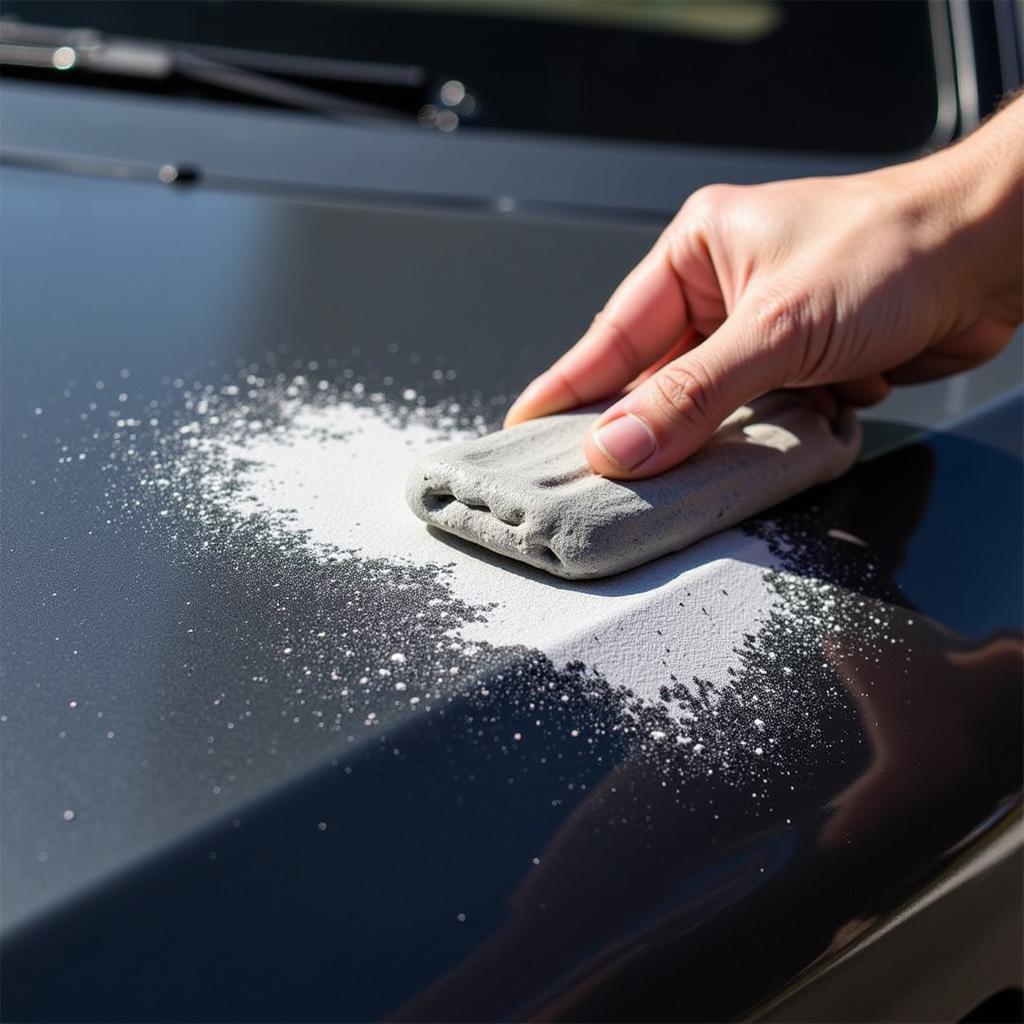Claying a car is a crucial step in achieving a truly flawless finish during a car detailing process. It removes embedded contaminants that washing alone can’t tackle, leaving your paint smooth as glass. This guide provides a comprehensive understanding of How To Clay A Car Detail, ensuring a professional-level result.
Why Clay Bar Your Car?
Washing your car removes loose dirt and grime, but contaminants like industrial fallout, tree sap, brake dust, and overspray often become embedded in the paint. These microscopic particles create a rough surface, preventing waxes and sealants from bonding properly and dulling the car’s shine. That’s where claying comes in. Claying removes these stubborn contaminants, restoring the paint’s smoothness and preparing it for polishing and protection.
 Clay bar removing contaminants from car paint
Clay bar removing contaminants from car paint
What You’ll Need for Claying
Before you start, gather the following:
- Clay Bar: Choose a quality clay bar appropriate for your car’s paint condition.
- Clay Lubricant: This is essential to prevent scratching. Dedicated clay lubricants are recommended.
- Microfiber Towels: Several clean, soft microfiber towels are necessary for wiping and drying.
- Bright Light Source: A strong light will help you identify contaminated areas.
How to Clay Bar a Car: A Step-by-Step Guide
- Wash and Dry Your Car Thoroughly: Ensure your car is completely clean and dry before claying. how to use car detailing clay provides a helpful guide on proper washing techniques.
- Knead the Clay: Warm and soften the clay bar by kneading it in your hands. Form it into a flat, patty-like shape.
- Lubricate the Surface: Spray a generous amount of clay lubricant onto a small section of the car’s paint (about 2ft x 2ft).
- Glide the Clay: Gently glide the clay bar across the lubricated surface using back-and-forth motions. Avoid applying pressure. The clay will pick up the contaminants, becoming dirty as you work.
- Fold and Knead: Regularly fold and knead the clay bar to expose a clean surface. Discard the clay if it becomes excessively contaminated.
- Wipe Clean: After claying a section, wipe the area dry with a clean microfiber towel.
- Inspect: Use a bright light to inspect the clayed area. If the surface feels smooth and the paint looks cleaner, move on to the next section.
- Repeat: Repeat steps 3-7 for the entire car, including the glass and painted surfaces.
Addressing Common Claying Concerns
- What if I drop the clay bar? Discard it immediately. Contamination from the ground can scratch your paint.
- Can I use soapy water as a lubricant? While some detailers use soapy water, dedicated clay lubricants are recommended for optimal lubrication and protection. Learn more about what is clay car detailer spray.
Tips for Effective Claying
- Work in a shaded area to prevent the clay lubricant from drying too quickly.
- Don’t apply pressure when claying. Let the clay do the work.
- Keep the surface well-lubricated at all times.
- For severely contaminated paint, consider using a more aggressive clay bar. how to detail clay your car provides further information on this topic.
Conclusion
Claying your car, as detailed in this guide on how to clay a car detail, is a vital step in achieving a showroom-worthy finish. By removing embedded contaminants, claying restores your car’s paint to its original smoothness, allowing waxes and sealants to bond effectively and maximizing the shine.
FAQ
- How often should I clay my car? Generally, claying every six months or annually is sufficient, depending on the car’s exposure to contaminants.
- Can I clay a car with a ceramic coating? Yes, but use a dedicated clay bar designed for coated cars.
- Can claying damage my paint? If done correctly with proper lubrication, claying is safe and will not damage your paint.
- What’s the difference between a clay bar and a clay mitt? A clay mitt offers a larger surface area and can be easier to use, while a clay bar provides more precision in tight areas. You can learn more about using a clay bar with how to use car detailing clay bar.
- What should I do after claying my car? After claying, it’s essential to polish and protect the paint with a wax or sealant. For those using Wilson products, check out our guide on how to clay bar a car wilson auto detail.
- Can I reuse a clay bar? Yes, as long as you haven’t dropped it and you keep kneading it to expose a clean surface.
- How do I know if my car needs claying? Run your hand across the freshly washed paint. If it feels rough or gritty, it likely needs claying.
Need help with your car detailing needs? Contact us via WhatsApp: +1(641)206-8880 or Email: [email protected]. Our 24/7 customer support team is ready to assist.

Leave a Reply